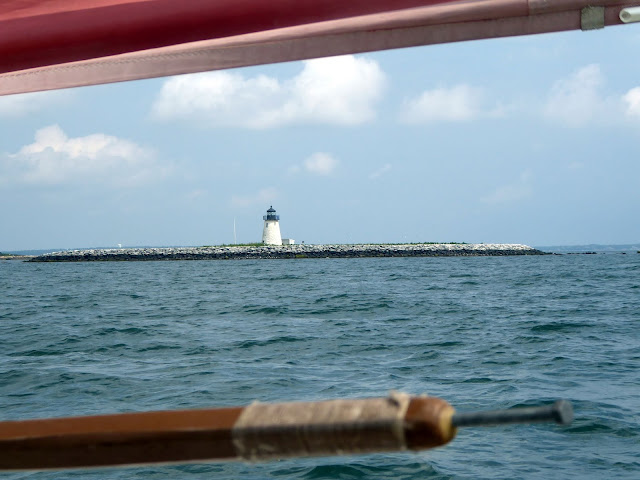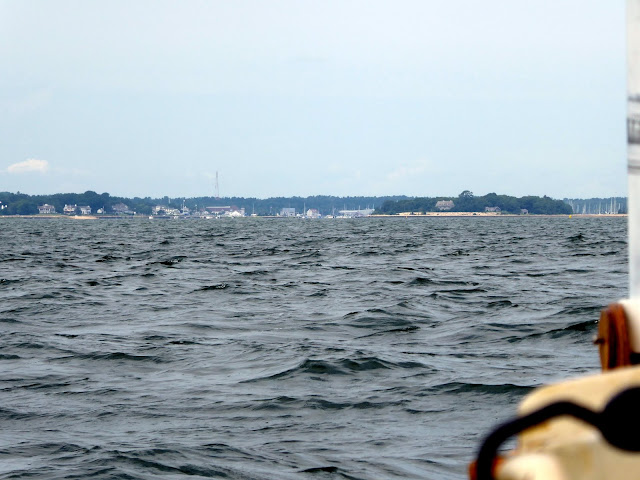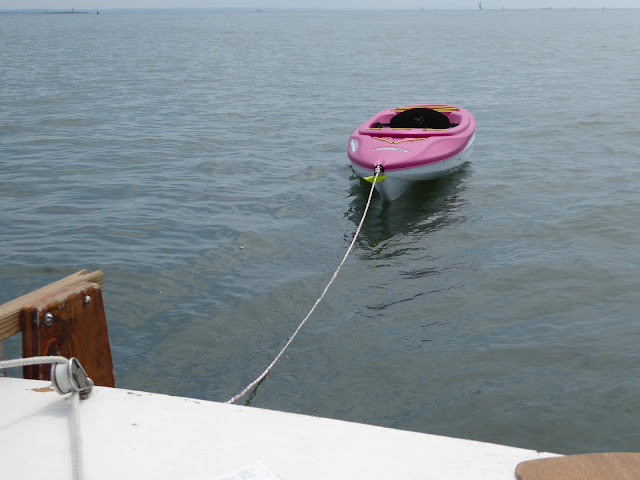The National Weather Service marine forecast that came over the radio as I ate dinner in Quisset Harbor was for winds of 5-10 knots with possible thundershowers in the morning, strengthening to 10-15 knots in the afternoon. I decided I needed to be anchored early in the afternoon; that would necessitate a little editing. A deep dive into Onset or Wareham would add hours to the trip, because it would be "uphill" (into the wind) to get out of those places. If I went only as far northeast as Pocasset Harbor in Falmouth, I could then cut across to Marion and probably make it before the wind got too strong.
I was up early and weighed anchor at about 7pm to make the most of my morning. Winds were light, but in direction perfect for departure.
My wanderings brought me quickly to the Sippican Historical Society on Front Street. Just as the last time I was here, it was closed--no hours on Thursdays. Unlike last time, a women say me sitting on the bench outside, poked her head out, and invited me in. She is the Society's new archivist, and would be happy to allow me to wander the rooms while she caught up on work. I must have wandered for almost an hour, fascinated by some of the people who called Marion home, or summered there, in its heyday in the early 20th century. Cecil Clark Davis painted portraits of some of the luminaries who passed through; on the walls are portraits of Charles Lindberg, and Roald Amundsen. She was married for a time (a platonic marriage) to another luminary, the journalist and novelist Richard Harding Davis. Another Marionite of note was illustrator Charles Dana Gibson, whose ink drawings set the style for the stylish American upper classes for over a decade.
Leaving the Historical Society (Laura had a dinner date with her husband), I walked Water Street in search of the house where Grover Cleveland summered two of the years between his presidential terms. You will know it, Laura told me, by the croquet pitch. It would have been an unmistakable house, with its rounded angles around the dormers, but the croquet pitch clinched it.
Other houses on Water Street, some historic, caught my eye.
As I ate my breakfast, the gulls and terns got theirs.
I was up early and weighed anchor at about 7pm to make the most of my morning. Winds were light, but in direction perfect for departure.
These West Falmouth waterfront homes must belong to very large families!
Less than an hour out of Quisset, I began hearing unfamiliar sounds from the sky. It didn't sound like thunder and I couldn't place it. I wondered if there were supersonic fighter jets passing by at high altitude. Trying to characterize the sound to myself, it was a short but steady sound, like a rolled "R." God practicing rolling his Rs. Eventually it got near enough to convince me it was indeed thunder. The sky ahead was dark with cloud, but too distant and hazy to be a clearly thunder clouds. I was not interested in sailing any closer to it. I have only once been caught out in a thunderstorm--well out in Cape Cod Bay--and I had no desire to repeat the experience. Considering the chart, I thought I could probably slip into little West Falmouth Harbor, but when I saw it, the entrance looked a bit narrow. The wind had definitely begun to rise. With no other port in this storm, I headed in.
A favorable wind meant there were no issues coming in, and I snugged right up to a beach--someone's back yard, really--and dropped anchor. I sat for almost an hour, moving the mizzen to the reefing step and listening to the radio, and finally headed back out. Exiting the harbor was no more difficult than entering it.
I had left the mainmast stepped, on the theory that the wind resistance it presented wouldn't be important with the wind more-or-less behind me. As I headed deeper into the bay, I consulted the chart for the next step. With an hour less to sail, my sail area much reduced, and the main sticking into the sky like a giant wind break, I decided not to attempt any harbor at all on the Falmouth side. In fact, to avoid sailing any distance into the wind, I would cut straight across from Nye's Neck, northwest the 6 nautical miles into Sippican Harbor, Marion. With luck, I could do it on one tack.
Parked a couple dozen yards off someone's backyard.
West Falmouth Harbor is partly closed by a rock barrier that initially gave me pause.
Out of the harbor, creaming along in a good breeze and rising seas.
Past beaches...
...and sailing lessons. (I decided it wasn't a race, because boats were going every which way.)
And then cutting across the bay, past the Cleveland Ledge Channel that leads to
the Cape Cod Canal, past the Cleveland Ledge Light (just visible in the haze)…
…to Bird Island Light, marking the entrance to Sippican Harbor.
Fishing.
Marion also has large families.
Yachts anchor behind Ram Island, ahead, deep in the harbor.
But approaching Ram Island the wind dropped. We were moving so slowly that
the painter towing the kayak was slack. I thought that was slow, but then
the line dipped below the water... Would I ever get there?
In a boat that sails in 4 feet of water and can float in 1, I often ignore channel markers.
I made an exception in this case.
The wind came back, and a gorgeous, old, wooden, gaff-rigged Herreshof cruised by.
Dropping anchor behind Ram Island, I cleaned myself up,
changed into my shore-going rig, and paddled into town.
My wanderings brought me quickly to the Sippican Historical Society on Front Street. Just as the last time I was here, it was closed--no hours on Thursdays. Unlike last time, a women say me sitting on the bench outside, poked her head out, and invited me in. She is the Society's new archivist, and would be happy to allow me to wander the rooms while she caught up on work. I must have wandered for almost an hour, fascinated by some of the people who called Marion home, or summered there, in its heyday in the early 20th century. Cecil Clark Davis painted portraits of some of the luminaries who passed through; on the walls are portraits of Charles Lindberg, and Roald Amundsen. She was married for a time (a platonic marriage) to another luminary, the journalist and novelist Richard Harding Davis. Another Marionite of note was illustrator Charles Dana Gibson, whose ink drawings set the style for the stylish American upper classes for over a decade.
Leaving the Historical Society (Laura had a dinner date with her husband), I walked Water Street in search of the house where Grover Cleveland summered two of the years between his presidential terms. You will know it, Laura told me, by the croquet pitch. It would have been an unmistakable house, with its rounded angles around the dormers, but the croquet pitch clinched it.
President Cleveland summered the four years between his terms in Marion, twice in this house.
The croquet pitch is out of sight to the left. I learned that Cleveland Ledge (and the
light I passed sailing in) is so named because it was his favorite fishing place.
Other houses on Water Street, some historic, caught my eye.
A brook flows behind this gate into the salt marsh.
Imagine having a breezeway with this view.
Some people are never satisfied.
First house on Water Street.
The purpose and history of this tiny house are mysteries to me.
It seems small to be a garage.
An inn or pub, if I recall.
The old houses here were generally built in the 1800s. This is an exception.
These folks are just as determined to maintain their property as I am mine.
President Lincoln's private secretaries (and biographers)
John G. Nicolay and John M. Hay summered in this house.
It's one of the few times I was stopped in my tracks by a historical plaque.
History is thirsty work. Looking for some food and drink sent me first to Kate's, which was closed, then to the General Store, which had a selection of ready-to-eat food but wouldn't take a credit card, and finally to Sea Dips ice cream shop--which would only take my card if I spent ten dollars or more. Ice cream for dinner! It took a little creative accounting to make everything work out, but I got to enjoy my ice cream in air-condioned comfort and went back to the beach well-satisfied.
Two boats coming in under asymmetric spinnaker. Are they racing? (A trick question.) Besides official races, sailboats are nearly always racing when they have a neighbor of similar size going in the same direction on the same stretch of water. Previously relaxed sailing will subtly give way to disciplined sail trimming, and the helmsman will put down their book or beverage and become attentive to the slightest shift of wind, and the ruffled water that shows where air is moving. Progress can be judged by watching your competitor's boat against background trees. To outward appearance, neither crew will even be aware of the others existence. And of course both skippers will strenuously deny they were ever racing--especially the loser.
A panoramic look at the anchorage, with close-ups of some of the residents.
Showing-off such a handsome wooden hull must cost a mint in upkeep.
Sunset.
Night.
My favorite place to sit and relax or read once the sun is gone is the port bench, using the
cabin as a backrest. The only think lacking is a good place to put my wine glass.





































































No comments:
Post a Comment